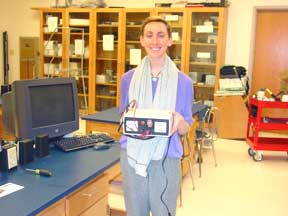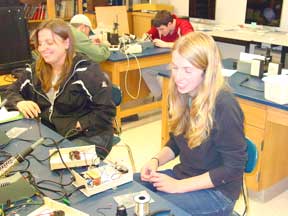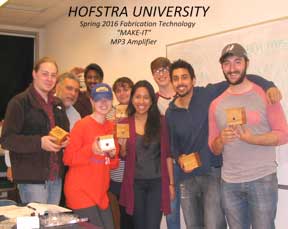Fabrication Technology for Physics Students: The Make-it Class
Steve Campolo, Hofstra University
Harold M Hastings, Bard College at Simon's Rock and Hofstra University
“With the skills that I developed in this class, I went on to build a Tesla coil of my own, for use in demonstrations in the high school physics class I currently teach.” — Nicole Spinelli, now a Secondary School Teacher and Adjunct Instructor of Physics teaching labs at Hofstra University
We describe our implementation of a “Make-it” class to complement the traditional Junior Lab for Physics majors, joint Physics and Education majors, and other STEM students and present an initial, informal assessment of its effects upon their development and career path. Students learned to apply critical thinking toward practical applications of science and began to understand how to bring practical learning into the classroom using a hands-on approach by constructing a professional looking electronic project from scratch.
The Junior Lab in Physics is intended to bridge the gap between introductory laboratories — which are designed to teach and reinforce concepts and the experimental method, as well as to provide the students with an introduction to laboratory techniques — and the demands of experimental research. As Chair of a small but reinvigorated and growing department, one of us (HMH) faced the challenge of re-starting and running a good, useful Junior Lab experience for very small enrollments. At the same time, this challenge seemed to offer an opportunity. Although traditional Junior Labs typically involve more complex experiments than introductory labs, many still use laboratory “kits.” As good as these packaged labs are, they cannot meet important learning objectives for Physics — Secondary Education majors. Objectives also important to students aiming for careers in the sciences with or without graduate education are:
- The ability to develop or modify laboratory apparatus,
- An understanding of the process of design (understand/adapt/implement), assess, redesign, repeat until success,
- Critical fabrication skills.
This led to our initial approach: to develop and perform a “classic” measurement from scratch — in this case, the unit of quantized conductance. This approach offers the potential of a more active and satisfying experience, as well as a greater development of “lab shop” skills, but it may also carry a higher risk of failure. With the supervision of HMH, Mark Sheingorn, a Physics and Education major, found the unit of quantized conductance to be approximately 12,300 ohms using apparatus that he developed and built.[1]
We offered the first Make-it class, consisting of three projects, to eight students in 2011. For the first two projects, students worked in teams to construct a simple cloud chamber (a fish tank with an electrically heated, alcohol-soaked felt pad on top and dry ice on the bottom) and a simple version of the MIT Haystack Observatory “very small radio telescope”[2],[3] to observe radio emissions from the sun, with the addition of a simple, steerable mount, but no interferometer. The third project was to fabricate a regulated, variable voltage DC power supply in a professional-looking plastic housing. Students learned soldering, wiring, and fabrication skills in addition to applications of elementary circuit theory. Finally, students took their power supplies home, providing direct, personal experience with ownership of their work. One student, Emma Katz, removed the batteries from her calculator, set the power supply to 6 volts, and connected the test leads to the battery terminals. “It works” Emma exclaimed upon seeing the display light up.
The 2011 course proved too ambitious, so the 2012 course taught by SC focused on a single project: the fabrication of a variable, regulated DC supply. This provided a more unified and deeper student experience, in particular a closer connection between theory and practice. For example, students learned more about materials used in fabrication and the role of accurate measurement. As before, students gained ownership of their learning through construction of a professional looking and functioning project that they built. After receiving student feedback, we decided to replace this project with the construction of a battery-operated mp3 amplifier that could be connected to a smart phone.
Make-it and an analogous Circuits lab are each 1 credit hour. These labs are not intended to replace engineering labs, but rather to expose students who would not normally take engineering lab courses to practical and applied science. The Circuits lab is an analogous extension of the Electricity and Magnetism course, providing complementary experience in construction and experimentation. Students construct RC timing circuits, transistor switches, transistor amplifiers, and then a transistor oscillator using their RC circuit for timing. Finally, students build integrated circuit amplifiers and oscillators and learn how gain is multiplied in cascaded amplifiers.
Materials for these courses cost approximately $100 per student. A basic machine shop can be equipped for under $10,000, but much can be accomplished with hand tools. Details and syllabi can be obtained from the corresponding author, SC.
Outcomes. Several physics majors entered the engineering workforce after graduation. One, a quality engineer in the aerospace field, reported that the experience of becoming familiar with the oscilloscope was invaluable to him. A student employed by an electronics firm was told after being hired that his explanation of his Make-it project set him apart from other job applicants. High school teacher and adjunct instructor Nicole Spinelli stated “The highly effective nature of this course reinforces that though it is important to learn, being capable of building something with what you have learned should be the true goal of education,” her own version of Feynman’s famous quote “What I cannot create, I do not understand.”[4] Another electrical engineer explained his experience as follows: “The course was essential to me in both my college and professional career. Now that I am pursuing a career in electrical engineering I use skills gained in the class on a daily basis.”
Annual enrollment has grown slowly and steadily from eight students in 2011 to 10-16 students in recent years. Most Physics majors take at least one of the Make-it and Circuits classes.
Hofstra University is a primarily undergraduate institution with total enrollment of 11,000, including 7000 undergraduates with an average SAT of 1180. The Department of Physics and Astronomy has eight full-time faculty members and 30-35 physics majors.
Steve Campolo is Adjunct Associate Professor of Physics and Laboratory Director. He is also Vice President — Engineering at Leviton Manufacturing Company and holds 33 US patents for electro-mechanical devices. Harold M Hastings is Professor Emeritus and former Chair of Physics at Hofstra, and adjunct faculty in Science at Bard College at Simon’s Rock. He co-founded two medical device companies. Both are radio amateur “hams,” KA2YHY and KD2OH, respectively.
Endnotes
[1] H.M.Hastings, and M. Sheingorn, The Junior Lab: A Case Study, Poster presentation at 2007 PhysTEC meeting, http://www.phystec.org/document/ServeFile.cfm?ID=4959&DocID=238&DocFID=270&Attachment=1.
[2] A. Rogers, P. Pratap, and D. Fields, Science and Technology through Radio Astronomy Experimentation for Community Colleges, Award Abstract #0535839, http://www.nsf.gov/awardsearch/showAward?AWD_ID=0535839.
[3] MIT Haystack Observatory Undergraduate Research SRT Interferometry,
http://www.haystack.edu/edu/undergrad/srti/index.html.
[4] J. Gleick, Genius: The life and science of Richard Feynman. Vintage, New York, 1992.

Nicole Spinelli displaying her professional looking power supply.

Student Emma Katz (foreground) powering her calculator.

Make-it class with mp3 amplifiers
Disclaimer – The articles and opinion pieces found in this issue of the APS Forum on Education Newsletter are not peer refereed and represent solely the views of the authors and not necessarily the views of the APS.
